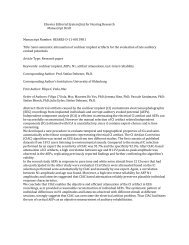Output frequency response function-based analysis for nonlinear ...
Output frequency response function-based analysis for nonlinear ...
Output frequency response function-based analysis for nonlinear ...
Create successful ePaper yourself
Turn your PDF publications into a flip-book with our unique Google optimized e-Paper software.
Based on the Volterra series expansion, the generalized <strong>frequency</strong> <strong>response</strong> <strong>function</strong> (GFRF) is proposed in<br />
George [16]. Thereafter, many researches on the <strong>frequency</strong> domain <strong>analysis</strong> of <strong>nonlinear</strong> Volterra systems are<br />
carried out [17–21]. By using this kind of <strong>frequency</strong> domain <strong>analysis</strong> method, <strong>nonlinear</strong> behaviour of a<br />
<strong>nonlinear</strong> Volterra system driven by a general input can be studied through its GFRFs and output spectrum.<br />
There<strong>for</strong>e, <strong>nonlinear</strong> characteristics in the <strong>frequency</strong> domain of a Volterra system can be revealed from a novel<br />
and effective perspective. A limitation of this method may lie in that estimation and computation of the<br />
GFRFs and Volterra kernels <strong>for</strong> a <strong>nonlinear</strong> Volterra system usually involve some complicated computation<br />
and symbolic operations [22]. It can be seen that a straight<strong>for</strong>ward analytical expression <strong>for</strong> the relationship<br />
between system time domain model parameters and system output <strong>frequency</strong> <strong>response</strong> can considerably<br />
facilitate the <strong>analysis</strong> and design of <strong>nonlinear</strong> Volterra systems in the <strong>frequency</strong> domain.<br />
For this purpose, a concept of the output <strong>frequency</strong> <strong>response</strong> <strong>function</strong> (OFRF) <strong>for</strong> <strong>nonlinear</strong> Volterra<br />
systems was proposed in Lang et al. [23], which defines an analytical relationship between system output<br />
spectrum and model parameters. The detailed structure of this relationship was studied in Jing et al. [24]. By<br />
using this explicit relationship, system model parameters of interest can be directly related to an engineering<br />
<strong>analysis</strong> and design objective which is dependent on system output <strong>frequency</strong> <strong>response</strong>, and the system<br />
output <strong>frequency</strong> <strong>response</strong> can be analysed in terms of some model parameters of interest. There<strong>for</strong>e,<br />
<strong>based</strong> on the theoretical results established recently by the authors, a novel systematic approach to the<br />
<strong>frequency</strong> domain <strong>analysis</strong> of <strong>nonlinear</strong> Volterra systems is proposed in this paper. The new approach,<br />
referred to as OFRF-<strong>based</strong> <strong>analysis</strong>, allows <strong>analysis</strong> and design of output <strong>frequency</strong> <strong>response</strong> of <strong>nonlinear</strong><br />
Volterra systems to be conducted in terms of system time domain model parameters with respect to any a<br />
specific input signal. A general procedure is proposed <strong>for</strong> the new <strong>frequency</strong> domain <strong>analysis</strong> method, and<br />
some fundamental results and practical techniques are developed to support and facilitate the application of<br />
this new method.<br />
The paper is structured as follows. Section 2 introduces the background of this study and provides some<br />
theoretical results established recently. Based on these theoretical results, a general procedure and some<br />
algorithms <strong>for</strong> the determination of the OFRF <strong>for</strong> a given NDE or NARX model are proposed and discussed<br />
in Section 3. Some useful results and techniques are developed in Section 4.1, especially <strong>for</strong> the <strong>analysis</strong> of<br />
<strong>nonlinear</strong> Volterra systems with respect to any specific model parameters, and what the OFRF-<strong>based</strong> <strong>analysis</strong><br />
can deal with are summarized in Section 4.2. Section 5 provides an example to illustrate the new method. A<br />
summary is given in Section 6.<br />
2. Fundamental concept of the OFRF-<strong>based</strong> <strong>analysis</strong> <strong>for</strong> <strong>nonlinear</strong> systems<br />
Nonlinear systems considered in this paper can be described by the following <strong>nonlinear</strong> differential equation<br />
(NDE) model:<br />
X M<br />
X m<br />
X K<br />
m¼1 p¼0 l1;lpþq¼0<br />
where d 1 xðtÞ=dt 1<br />
l¼0<br />
cp;qðl1; ...; lpþqÞ Yp<br />
i¼1<br />
d li yðtÞ<br />
dt li<br />
¼ xðtÞ, p+q ¼ m, PK<br />
Y pþq<br />
i¼pþ1<br />
¼<br />
l1;lpþq¼0<br />
PK<br />
l1¼0<br />
d li uðtÞ<br />
dt li<br />
¼ 0, (1)<br />
P K<br />
lpþq¼0<br />
ð Þ, M is the maximum degree of <strong>nonlinear</strong>ity in<br />
terms of y(t) and u(t), and K is the maximum order of the derivative. In this model, the parameters such as<br />
c0,1(.) and c1,0(.) are linear parameters, which correspond to the linear terms in the model, i.e., d l yðtÞ=dt l and<br />
d l uðtÞ=dt l <strong>for</strong> k ¼ 0,1, y, K, and cpqð Þ <strong>for</strong> p+q41 are <strong>nonlinear</strong> parameters corresponding to <strong>nonlinear</strong> terms<br />
in the model of the <strong>for</strong>m:<br />
Y p<br />
i¼1<br />
d li yðtÞ<br />
dt li<br />
Y pþq<br />
i¼pþ1<br />
d li uðtÞ<br />
dtli ,<br />
ARTICLE IN PRESS<br />
X.J. Jing et al. / Mechanical Systems and Signal Processing 22 (2008) 102–120 103<br />
e.g., y(t) p u(t) q . p+q is called the <strong>nonlinear</strong> degree of the <strong>nonlinear</strong> parameter cpqð Þ. Moreover, cpqð Þ and cp0q0ð Þ<br />
are referred to as different type of <strong>nonlinear</strong>ity if p6¼p0 or q6¼q0 . Similar to the NDE model (1), a discrete<br />
<strong>nonlinear</strong> model known as NARX model is often used <strong>for</strong> practical <strong>nonlinear</strong> system identification from

















